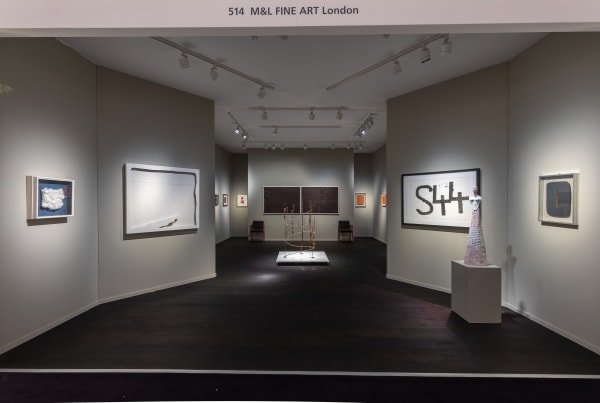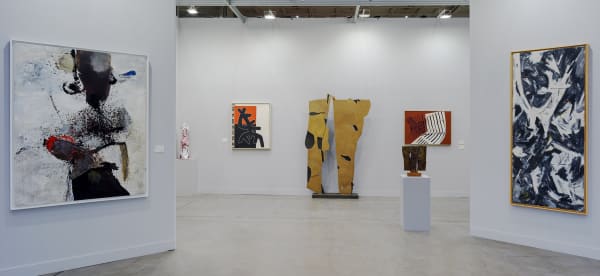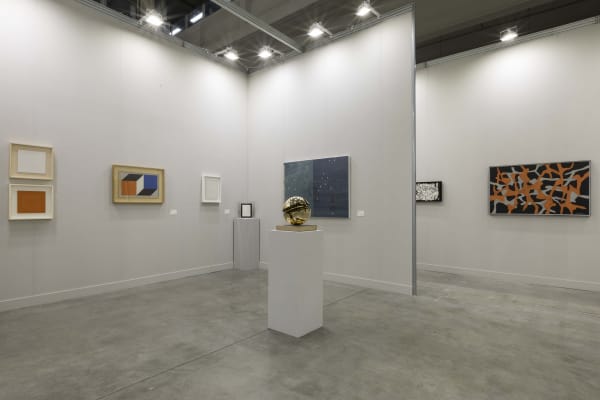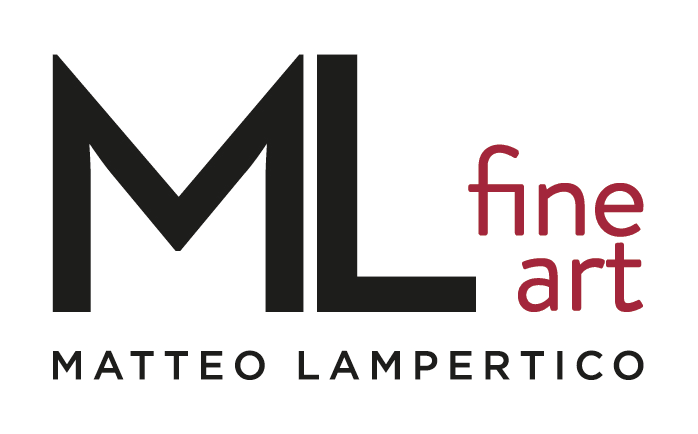Hans Hartung German, 1904-1989
Hans Hartung’s dynamic and experimental practice evokes a powerful sense of self expression. His singular visual language established him as a leader in the field of 20th century abstraction and has had a profound influence over subsequent generations of artists, in particular proving inspirational to the trajectory of American lyrical abstraction in the 1960s and 1970s.
Born in Leipzig, Germany in 1904, Hartung studied at art schools in both his hometown and Dresden. In the years preceding the outbreak of the Second World War he settled in Paris, where he became acquainted with artists including Wassily Kandinsky, Alexander Calder and Joan Miró, and struck up a close friendship with sculptor, Julio González. Associated with the Art Informel and Taschist movements, Hartung would become of one of France’s most significant post-war artists, renowned for his dramatic and innovative approach to abstraction.
Concerned with the translation of the inexpressible onto canvas, Hartung’s emotional abstractions eliminated all figurative elements, pursuing such freedom of gesture and spatial dynamism with a litany of non-traditional tools, including spray guns, brooms and branches from the olive trees that grew in the grounds of his home and studio in the south of France. Balanced between chance and control, Hartung’s oeuvre is unexpectedly pre-meditated. He observed, ‘At the beginning, I act in total freedom. Work, by following its own course, constrains me more and more, and I am less and less at liberty to choose'. His late painting, much of which was made from the confines of a wheelchair, is amongst the most vigorous of his near seven-decades-long career, presenting a renewed sense of freedom, energy and ambition.
Hans Hartung was born on September 21, 1904, in Leipzig, Germany.
He cultivated interests in philosophy, astronomy, music, and religion at a young age before he turned to painting. Early in his career he found inspiration in the works of Rembrandt van Rijn and Francisco de Goya, and later influences included Lovis Corinth, Oskar Kokoschka, Emil Nolde, and Max Slevogt. At just 17, Hartung began to experiment with abstraction, synthesizing the graphic techniques of his artistic models while completely eliminating figurative elements.
Hartung entered the Universität Leipzig in 1924 to study philosophy and art history but left to concentrate on painting at the Kunstakademie, Leipzig. While Hartung was advised to pursue further training at the Bauhaus, he opted to study at the Kunstakademie, Dresden. In 1926 Hartung saw an exhibition of international art in Dresden, which exposed him to Cubism and other modern styles that had emerged in France. His encounters with works by Georges Braque, Juan Gris, Henri Matisse, and Pablo Picasso, along with various travels abroad, encouraged him to move to Paris in 1926, where he spent the majority of his time until 1932, although he passed the summer of 1928 in Munich studying under artist and theorist Max Dörner.
In 1929 Hartung married the Norwegian painter Anna-Eva Bergman. After several years abroad, they tried to reestablish themselves in Berlin in 1935 but were soon forced into exile by the National Socialist regime. In the years leading up to World WarII, Hartung's work reflected his attempts to reconcile chance and control, combining expressive graphic elements with patches of black and color to produce a sense of spontaneity. After the outbreak of the war, Hartung served in the Foreign Legion (1939–40), and later in the Free French (1943–44). He was gravely wounded at the German Front, and one of his legs was amputated. In 1945 he returned to Paris and resumed painting and the following year earned French citizenship.
Hartung was a major figure in Art Informel and Tachisme (from the French tache, meaning blot or stain). While Hartung's postwar paintings are generally described as exhibiting a calligraphic quality, his work moved through a series of phases, becoming less spontaneous and more formally aggressive than his work from the late 1930s. In many works of the late 1940s and early 1950s, such as T-50 Painting8 (T-50 peinture8, 1950), he applied large areas of color to the canvas on which he painted a combination of bold black brushstrokes and thinner frenetic linear strokes.
Hartung received several international awards, including the 1956 award for the Europe-Africa section at the Guggenheim International Award and the International Grand Prize for painting at the 1960 Venice Biennale. His first major group show was organized by curator and critic Christian Zervos at the Jeu de Paume, Paris (1937). After settling permanently in Paris, he exhibited regularly at the Salon des Surindépendants (1935, 1937, 1945). His first solo show took place at Galerie Lydia Conti (1947) and was followed by other early exhibitions at Galerie de France (1956) and Galerie Craven (1956). Major international presentations include Younger European Painters: A Selection, Guggenheim Museum (1953–54); a retrospective at Musée national d'art moderne, Paris (1969); and solo exhibitions at Metropolitan Museum of Art, New York (1975) and Musée d'art moderne de la Ville de Paris (1980).
Hartung died on December 7, 1989, in Antibes, France.
-

TEFAF Maastricht 2020
4 - 11 Mar 2020We are pleased to announce our participation at TEFAF Maastricht 2020. Our booth will showcase a selection of historically relevant paintings, sculptures and works on...Read more -

MIART 2019
5 - 7 Apr 2019Galleria Matteo Lampertico is pleased to partecipate at Miart 2019. Our booth will present a selection of works by Italian and International artists, including Pietro...Read more -

MIART 2018
13 - 15 Apr 2018Galleria Matteo Lampertico is pleased to partecipate at Miart 2018. Our booth will present a selection of works by Italian and Internartional artists, including Alighiero...Read more






